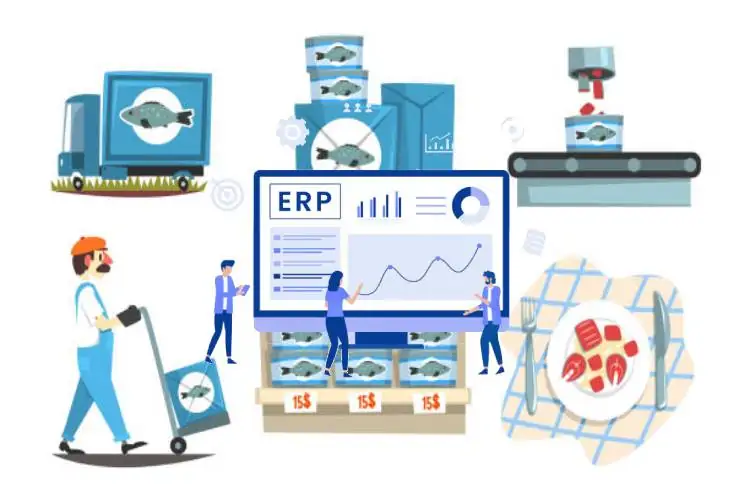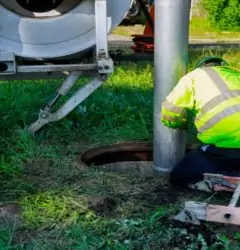15 Dec

From lot tracking to by-product costing, the seafood ERP offers numerous features to facilitate the seafood industry to customize, monitor, and control the seafood supply chain.
The Food and Agriculture estimates that around 35% of seafood and fish are wasted during the supply chain, starting from fish post-catch, processing, and final distribution. Not only that but 60% of seafood is wasted in processing and distribution processes only.
That’s why the seafood industry should implement ERP to plan and manage the supply chain operations. This way, the seafood distributors can increase the revenue by lowering the waste. Not only that, but the companies can track and distribute the orders effectively.
Challenges Faced by the Seafood Industry
The seafood industry faces different problems to ensure the freshness and sustainability of seafood. Moreover, the companies have to fulfill the demands of the local and overseas buyers and provide fresh and quality seafood.
Furthermore, traceability is also a major concern of seafood companies, especially while distributing the products to overseas consumers. Similarly, the companies can monitor the environmental conditions of warehouse and transit storage to minimize food waste.
Seafood ERP as Solution
The seafood ERP revolutionaries the concept of the seafood supply chain with the latest artificial intelligence technology to trace and trace the quality and freshness of the seafood products. Moreover, the seafood ERP ensures planning, scheduling, purchasing, warehousing, shipment, inventory, and distribution.
Furthermore, an advanced cloud-based ERP solution offers access to real-time data and other insights to customize the reports and dashboard.
This way, the suppliers can improve their management and procurement processes to minimize time delays and other operational limitations.
Lastly, the seafood ERP offers transparency and traceability to access the record of the seafood products from the origin to the final distribution.
The catching and Harvester’s profile management allows the seafood companies to make well-informed decisions about the vendors and other purchases. Additionally, condition monitoring offers real-time data reports regarding temperature, humidity, and water control sensors.
The dedicated ERP module manages different operations to ensure quality control to offer premium-quality products to the end consumers.
Also Read: Seafood HACCP Guidelines
Advantages of Seafood ERP
Read along to learn about the benefits of implementing ERP in the seafood industry.
Quality Checks
Product quality and shelf-life are among the biggest challenges faced by the seafood industry. That’s why companies focus on delivering fresh products to prevent health hazards among consumers. The seafood ERP offers advanced quality checks by ensuring product quality at different processing stages.
The ERP software also checks other physical attributes of the seafood such as size, weight, microbial, and chemical requirements. This way, the ERP software ensures through checks to fulfill the quality checks throughout the supply chain.
Traceability
The ERP software offers traceability by allotting a lot number to the products. Not only that, but the lot number contains complete information about the manufacturing and expiry date.
Order Management
The primary goal of the ERP software is to systemize order management to streamline the workflows and other operations. The way the companies can manage and update the work orders to ensure timely delivery of the fresh products.
Purchasing
In addition to order completion and management, ERP ensures smart purchasing by comparing the cost offered by different vendors. Furthermore, the ERP software analyses the demand and other market trends allowing the companies to buy the seafood which is in demand.
Furthermore, the ERP offers smart pricing options to businesses by recording price variations for different reasons. The management can look at the historical trends to compare the cost and set the new prices accordingly.
Inventory Management
One of the biggest concerns of the seafood industry is the expiry of the products available in the inventory. Furthermore, managing the waste is another challenge. However, the seafood ERP allows the companies to relocate the waste separately from the regular and fresh products.
This way, the companies can save time and resources by smartly managing the inventory.
Supply Chain Management
The ERP software allows the companies to track and manage the shipment. Not only that, but the payment modes are also an integral part of the payment tracking module of ERP.
Hence the companies can ensure productivity and cost-effectiveness by integrating different modules and workflows of the entire seafood supply chain.
Customer Experience
Since the companies ensure the delivery of fresh seafood products to the consumers, they ensure improved customer experience and satisfaction.
Order Patterns
The ERP records and stores all the historical orders by maintaining the customer information and the respective orders. This way, the ERP analyzes the fish demand and most ordered variety of fish and other seafood products.
Prediction
The ERP analyses the customers’ orders, behaviors, and seasonal changes in orders. This way, the companies can plan and manage the inventory accordingly by forecasting the seafood demand and supply.
Marketing
The ERP software allows companies to devise different marketing campaigns and strategies. Moreover, the fisheries and seafood industries can request customer reviews and feedback and offer discounts to loyal customers.
Conclusion
The primary takeaway of the above guide is to understand the features and benefits of seafood ERP to ensure product quality and compliance with the seafood safety regulations.
The seafood industry is fast-paced, where different processes and operations occur simultaneously. Hence, an Enterprise Resource Planning ERP software streamlines all the processes from sourcing to transportation by including packing, processing, and quality checks in between.





Ecodocs